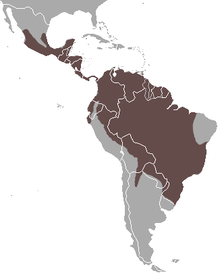Tayra
| Tayra | |
|---|---|
 |
|
| Scientific classification | |
| Kingdom: | Animalia |
| Phylum: | Chordata |
| Class: | Mammalia |
| Order: | Carnivora |
| Family: | Mustelidae |
| Subfamily: | Mustelinae |
| Genus: |
Eira Hamilton Smith, 1842 |
| Species: | E. barbara |
| Binomial name | |
|
Eira barbara (Linnaeus, 1758) |
|
 |
|
| Tayra range | |
The tayra (Eira barbara), is an omnivorous animal from the weasel family, native to the Americas. It is the only species in the genus Eira.
Tayras are also known as the tolomuco or perico ligero in Central America, motete in Honduras, irara in Brazil, san hol or viejo de monte in the Yucatan Peninsula, and high-woods dog (or historically chien bois) in Trinidad. The genus name Eira is derived from the indigenous name of the animal in Bolivia and Peru, while barbara means "strange" or "foreign".
Tayras are long, slender animals with an appearance similar to weasels and martens. They range from 56 to 71 cm (22 to 28 in) in length, not including a 37 to 46 cm (15 to 18 in) long bushy tail, and weigh 2.7 to 7 kg (6.0 to 15.4 lb). Males are larger, and slightly more muscular, than females. They have short, dark brown to black fur which is relatively uniform across the body, limbs, and tail, except for a yellow or orange spot on the chest. The fur on the head and neck is much paler, typically tan or greyish in color. Albino or yellowish individuals are also known, and are not as rare among tayras as they are amongst other mustelids.
The feet have toes of unequal length with tips that form a strongly curved line when held together. The claws are short and curved, but strong, being adapted for climbing and running rather than digging. The pads of the feet are hairless, but are surrounded by stiff sensory hairs. The head has small, rounded, ears, long whiskers and black eyes with a blue-green shine. Like most other mustelids, tayras possess anal scent glands, but these are not particularly large, and their secretion is not as pungent as in other species, and is not used in self-defence.
Tayras are found across most of South America east of the Andes, except for Uruguay, eastern Brazil, and all but the most northerly parts of Argentina. They are also found across the whole of Central America, in Mexico as far north as southern Veracruz, and on the island of Trinidad. They are generally found only in tropical and subtropical forests, although they may cross grasslands at night to move between forest patches, and they also inhabit cultivated plantations and croplands.
...
Wikipedia

